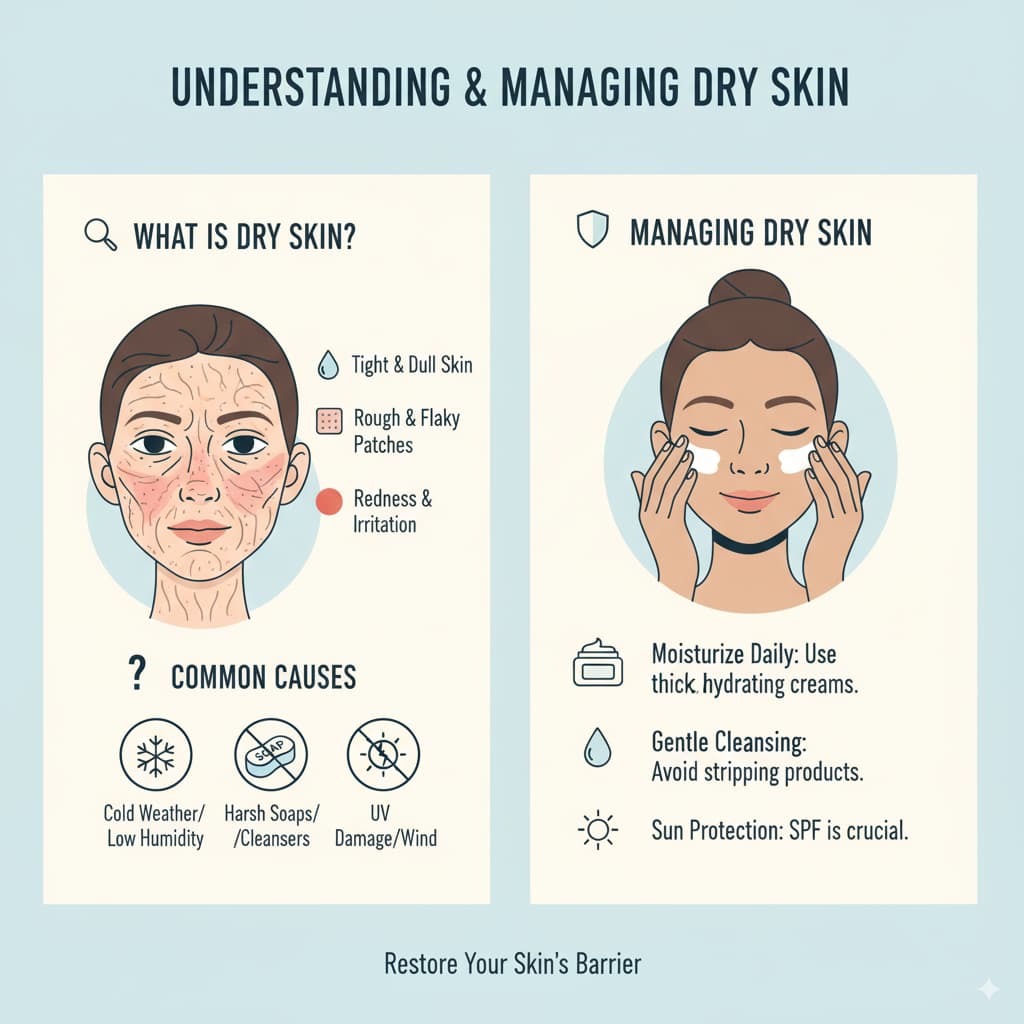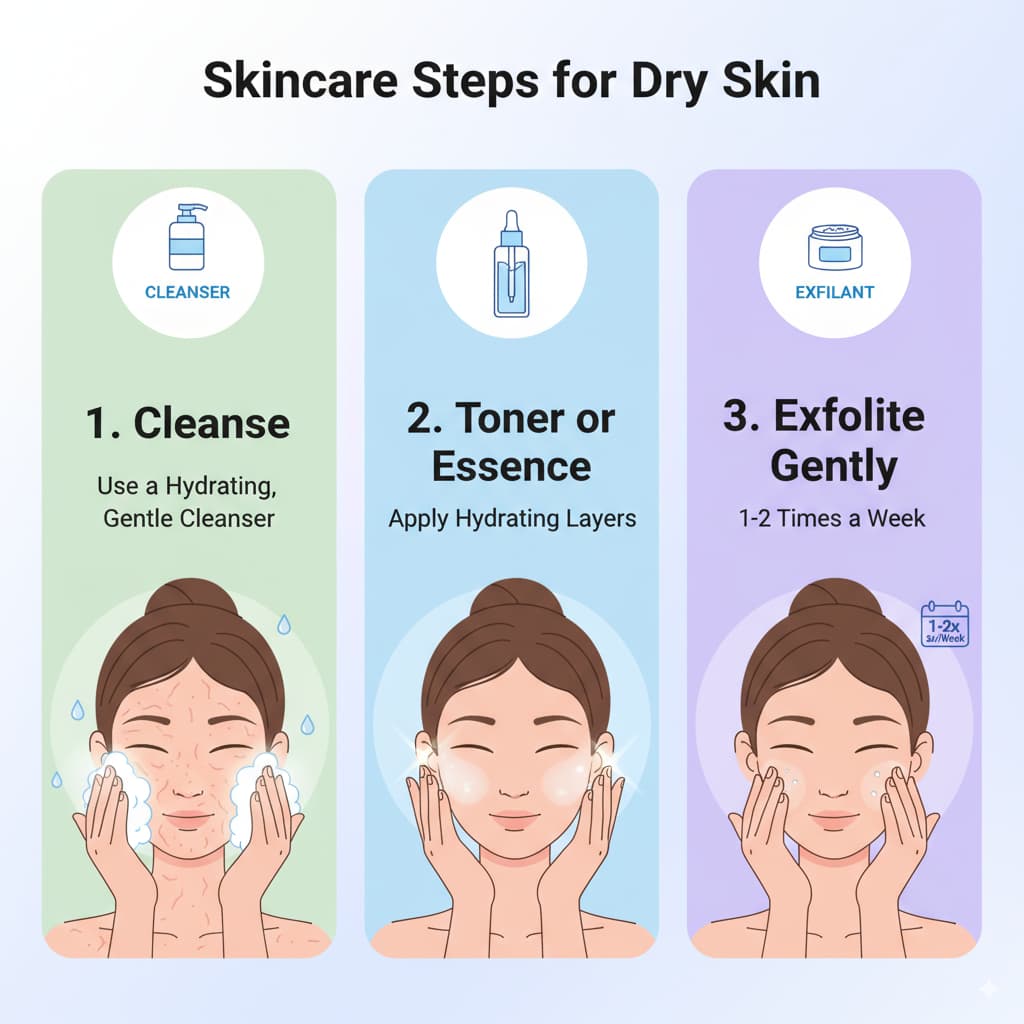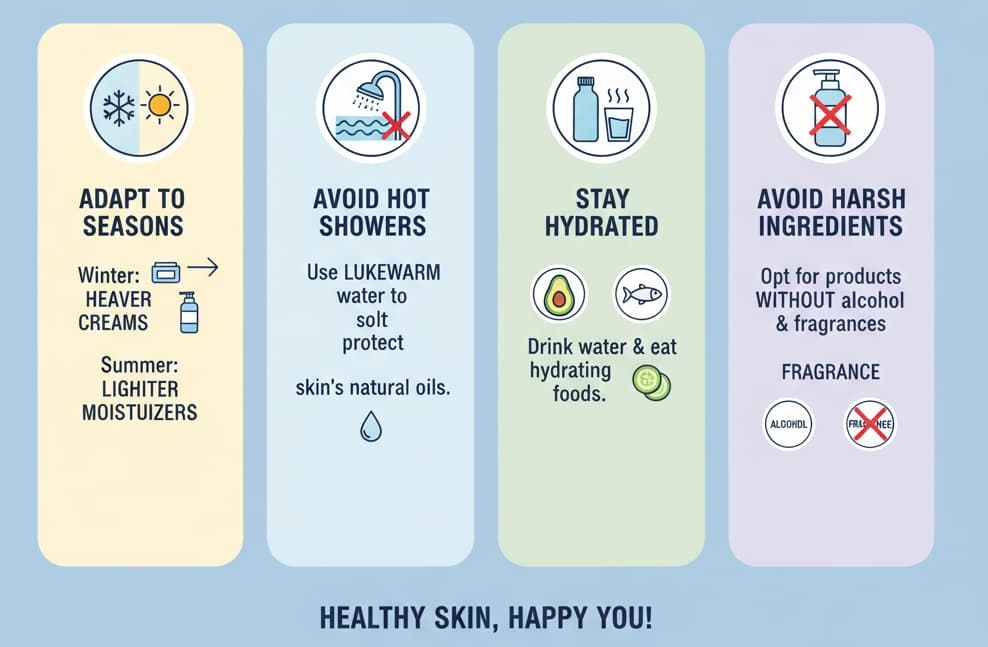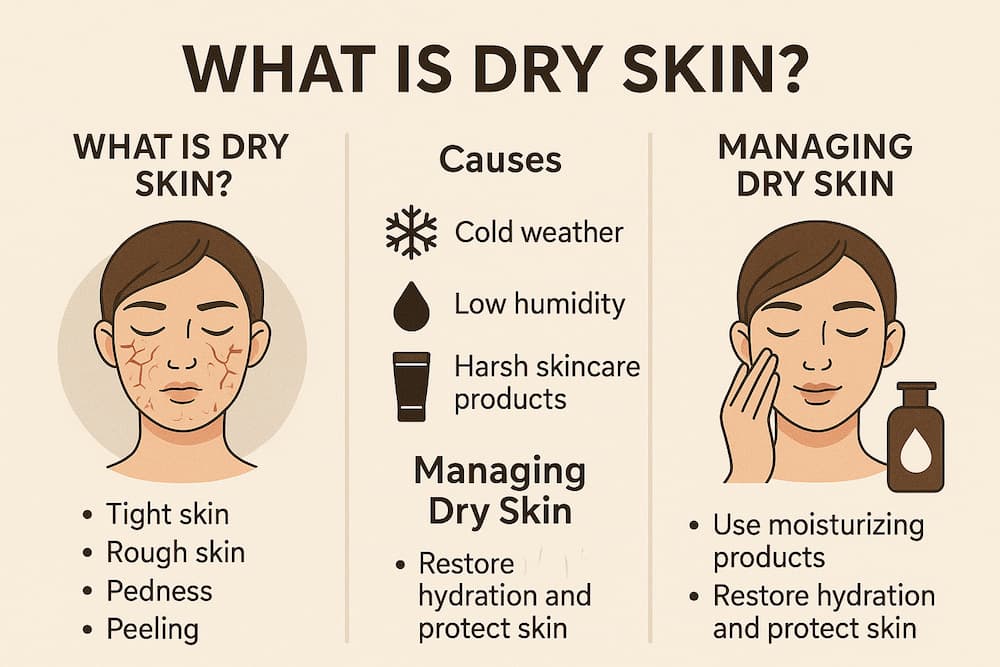Dry skin is a common issue in the UK due to the combination of cold winters, central heating, and exposure to various environmental factors. Managing dry skin requires a skincare routine that not only hydrates but also repairs and protects the skin’s natural moisture barrier. With the right products and techniques, dry skin can be kept nourished, plump, and glowing throughout the year. This guide will take you through the best skincare routine for dry skin, addressing the unique challenges of the UK climate.

Understanding Dry Skin
Dry skin, or xerosis, occurs when the skin loses moisture and is unable to retain enough water in the outermost layer, leading to tightness, rough texture, redness, and peeling. Various factors can contribute to dry skin, including cold weather, low humidity, and harsh skincare products that strip natural oils. The key to managing dry skin is to restore and maintain hydration, protect the skin’s moisture barrier, and prevent environmental stressors from further drying out the skin.

The Ideal Skincare Routine for Dry Skin
1. Cleanse with a Hydrating, Gentle Cleanser
The first step in any skincare routine is cleansing, and for dry skin, it’s essential to use a hydrating, gentle cleanser. Traditional soaps and harsh foaming cleansers can strip the skin of its natural oils, leaving it feeling tight and more vulnerable to environmental damage.
Opt for a cream-based or oil-based cleanser that effectively removes dirt and impurities without disrupting the skin’s natural moisture barrier. Look for cleansers with soothing ingredients like glycerin, hyaluronic acid, or ceramides, which help lock in moisture while cleaning the skin.

2. Use a Moisturizing Toner or Essence
After cleansing, using a toner or essence is an essential step for replenishing the skin’s moisture levels. Choose alcohol-free toners that contain hydrating ingredients like rose water, aloe vera, or hyaluronic acid. These ingredients help to restore moisture and prep the skin for the next steps in your skincare routine.
For dry skin, essences can also be a good option. They have a more concentrated formula than toners and are specifically designed to add moisture and improve skin hydration. The key is to avoid toners that contain alcohol or astringents, which can further dry out the skin.
3. Exfoliate Gently (1-2 Times a Week)
Exfoliation is crucial for dry skin to remove dead skin cells and promote the turnover of new skin. However, over-exfoliating can damage the skin’s moisture barrier, leading to further dryness and irritation. It’s important to exfoliate gently and avoid harsh scrubs.
Opt for chemical exfoliants with mild exfoliants like lactic acid or gentle AHAs that help remove dead skin cells without damaging the skin. These ingredients are hydrating and help maintain the skin’s moisture. Exfoliate 1-2 times a week to reveal smoother, healthier skin.
4. Use a Rich, Nourishing Moisturizer
Moisturizing is the cornerstone of any dry skin routine. For dry skin, it’s essential to use a rich, nourishing moisturizer that provides long-lasting hydration. Look for moisturizers that contain occlusive ingredients like petrolatum, shea butter, or dimethicone, which help to lock moisture into the skin and prevent dehydration.
Additionally, choose moisturizers with ceramides or hyaluronic acid, which help to restore the skin’s natural barrier and attract moisture to the skin. Make sure to apply your moisturizer immediately after cleansing and toning to lock in hydration while your skin is still damp.

5. Apply Sunscreen Every Day
Even dry skin requires sun protection. UV rays can further damage the skin, leading to dryness, premature aging, and pigmentation. Look for a hydrating, broad-spectrum sunscreen that provides SPF 30 or higher, with ingredients like glycerin, squalane, or ceramides to help hydrate and protect the skin.
Choose a sunscreen that is non-comedogenic and suitable for dry skin. If your sunscreen feels too heavy or greasy, opt for a lightweight formula with a matte finish that won’t make the skin feel oily.
6. Treat Specific Concerns with Face Oils
For extra hydration, face oils can be a great addition to your routine, especially during colder months. Oils help to seal in moisture and provide an added layer of protection for dry skin. Look for oils with ingredients like jojoba oil, rosehip oil, or squalane, which help replenish the skin’s moisture and improve skin texture.
Face oils are best applied after moisturizing, and just a few drops are usually enough to nourish and protect your skin.
Additional Tips for Managing Dry Skin in the UK

Adapt to the Seasons
The UK’s climate can change dramatically from season to season, and your skin’s needs may change with it. During the colder months, the low humidity and indoor heating can cause the skin to become more dehydrated. In summer, although the air is warmer, sun exposure can cause dehydration.
In the winter, consider using heavier creams or oils to provide extra nourishment, while in the summer, opt for lighter, water-based moisturizers that hydrate without feeling too heavy. Pay attention to how your skin reacts to seasonal changes and adjust your skincare routine accordingly.
Avoid Hot Showers
Hot water can strip your skin of its natural oils, leading to further dryness and irritation. When showering or washing your face, use lukewarm water instead of hot water to prevent damage to the skin’s moisture barrier.
Stay Hydrated and Eat Skin-Nourishing Foods
Drinking plenty of water throughout the day is essential for keeping your skin hydrated. Hydration starts from within, and eating foods rich in essential fatty acids, such as avocados, nuts, and fatty fish, can also help improve skin hydration. Vitamin E and vitamin C are also beneficial for dry skin and can be found in fruits, vegetables, and nuts.
Avoid Harsh Ingredients
Avoid using skincare products that contain alcohol, fragrances, or strong exfoliants. These ingredients can further irritate and dry out your skin. Stick to products that are formulated for sensitive or dry skin and always check ingredient labels for alcohol or other potentially drying agents.
FAQ: Common Questions about Dry Skin
- Why does my skin feel tight and dry?
Tightness and dryness occur when the skin loses moisture. This can be caused by environmental factors like cold weather, dry indoor air, or using harsh skincare products. - How can I keep my skin hydrated all day?
Apply a rich moisturizer immediately after cleansing to lock in hydration. Consider using a face mist throughout the day for an added boost of moisture, especially during colder months. - Should I use a toner for dry skin?
Yes, but make sure to use an alcohol-free toner that is hydrating. Look for toners with soothing ingredients like rose water or aloe vera to replenish moisture. - Can dry skin cause acne?
Yes, dry skin can lead to breakouts. When the skin becomes too dry, it may overproduce oil, leading to clogged pores and acne. Using the right moisturizer can help prevent this. - How often should I exfoliate dry skin?
Exfoliate dry skin 1-2 times a week to remove dead skin cells and improve skin texture. Avoid harsh exfoliants that can irritate the skin and strip it of moisture. - Can I use the same moisturizer in summer and winter?
In winter, you may need a richer moisturizer due to the dry air, while in summer, a lighter formula may suffice. Adjust your moisturizer based on the season and your skin’s needs. - Can face oils help with dry skin?
Yes, face oils can provide additional hydration and lock in moisture. Oils like jojoba oil or rosehip oil can be beneficial for dry skin. - What are the best ingredients for dry skin?
Look for ingredients like hyaluronic acid, glycerin, ceramides, squalane, and shea butter, which help to hydrate, nourish, and repair the skin’s moisture barrier. - Should I moisturize oily skin as well?
Yes, even oily skin needs moisture. The key is to use a lightweight, oil-free moisturizer that hydrates without clogging pores or increasing oil production. - How can I tell if my skin is dry or dehydrated?
Dry skin lacks oil, while dehydrated skin lacks water. Dehydrated skin may feel tight and look dull, and it can occur in both oily and dry skin types. Hydrating products can help with dehydration.

Conclusion
Managing dry skin in the UK requires a thoughtful approach, especially with the changes in seasons. By using hydrating, nourishing products, maintaining a consistent skincare routine, and adapting to environmental changes, you can keep your skin hydrated, healthy, and glowing. Pay attention to your skin’s needs, and remember that proper hydration is key to managing dry skin all year round.



